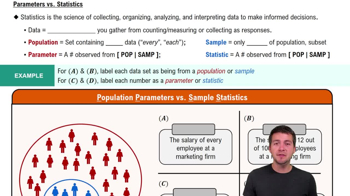Here are the essential concepts you must grasp in order to answer the question correctly.
Levels of Measurement
The levels of measurement describe the nature of data and determine the types of statistical analyses that can be performed. They include nominal, ordinal, interval, and ratio. Nominal data categorize without a specific order, ordinal data have a meaningful order, interval data have equal intervals without a true zero, and ratio data have equal intervals with a true zero, allowing for meaningful comparisons of magnitude.
Recommended video:
Difference in Proportions: Hypothesis Tests Example 1
Discrete vs. Continuous Data
Discrete data consist of distinct, separate values, often counted in whole numbers, such as the number of moons. Continuous data, on the other hand, can take any value within a range and are often measured, like height or temperature. Understanding whether data are discrete or continuous helps in selecting appropriate statistical methods and visualizations.
Recommended video:
Visualizing Qualitative vs. Quantitative Data
Units of Measurement
Units of measurement provide context and meaning to numerical data, ensuring clarity and precision. In the context of the number of moons, the unit is simply 'moons,' which is a count of natural satellites orbiting each planet. Including units is crucial for interpreting data correctly and communicating findings effectively.
Recommended video:
Parameters vs. Statistics






